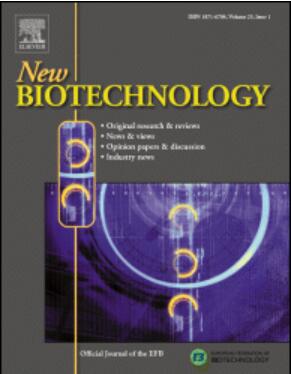Model-based engineering of Bacillus methanolicus towards de novo polyamine bioproduction from methanol
IF 4.9
2区 生物学
Q1 BIOCHEMICAL RESEARCH METHODS
引用次数: 0
Abstract
This study explores the one-carbon feedstock methanol to bolster sustainable bioproduction of valuable polyamines. Bacillus methanolicus MGA3, a methylotroph, stands out as a promising host due to its aptitude for employing methanol to synthesize various chemicals. Our approach used flux balance analysis (FBA) to leverage native B. methanolicus pathways for biosynthesis of the polyamines putrescine and spermidine. Despite possessing the genetic repertoire required for their production, B. methanolicus naturally secretes spermidine but not putrescine. Therefore, we created recombinant strains overexpressing endogenous and heterologous genes for putrescine biosynthesis via the arginine decarboxylase pathway, including arginine decarboxylase (speA) and agmatinase (speB). The B. methanolicus strain PUTEc, overexpressing speAB from Escherichia coli rather than native ones, achieved putrescine production of 47.5 ± 0.8 μM in shake flasks. Towards spermidine production, FBA pointed to overexpressing S-adenosylmethionine decarboxylase (speH) and spermidine synthase (speE) in the PUTEc strain. As a result, production of 83.9 ± 2.7 μM spermidine was achieved from methanol. Subsequently, the PUTEc strain underwent FBA-based screening involving precursor supplementation extracellularly in the growth medium or intracellularly by gene co-overexpression to enhance putrescine production. Overexpression of the endogenous ornithine biosynthesis pathway in the PUTEc strain yielded the highest methanol-based polyamine production in this study: 137.7 ± 1.8 μM putrescine in small-scale shake flask conditions. With further improvements in titer towards several grams per litre, this sustainable bioprocess could supply the steadily growing ∼ $500 M putrescine market. To our knowledge, this is the first proof-of-concept study towards production of putrescine and spermidine from methanol.
甲醇芽孢杆菌以甲醇为原料重新生产多胺的模型工程。
本研究探讨了单碳原料甲醇,以促进有价值的多胺的可持续生物生产。甲醇芽孢杆菌(Bacillus methanolicus MGA3)是一种甲基营养菌,它具有利用甲醇合成各种化学物质的能力,是一种很有前途的寄主。我们的方法使用通量平衡分析(FBA)来利用天然B. methanolicus途径来生物合成多胺,腐胺和亚精胺。尽管拥有生产所需的基因库,但B. methanolicus自然分泌亚精胺而不分泌腐胺。因此,我们通过精氨酸脱羧酶途径构建了过表达内源和外源基因的重组菌株,包括精氨酸脱羧酶(speA)和agmatinase (speB)。在摇瓶中,过量表达大肠埃希氏菌(Escherichia coli)而非天然菌株speAB的B. methanolicus菌株PUTEc的腐胺产量为47.5±0.8μM。在产亚精胺方面,FBA指出PUTEc菌株过表达s -腺苷蛋氨酸脱羧酶(speH)和亚精胺合成酶(speE)。结果表明,甲醇合成的亚精胺为83.9±2.7μM。随后,PUTEc菌株进行了基于fba的筛选,包括在生长培养基中添加细胞外或细胞内的前体,通过基因共过表达来增强腐胺的产生。在本研究中,PUTEc菌株过表达内源性鸟氨酸生物合成途径,在小型摇瓶条件下产生了最高的甲醇基多胺产量:137.7±1.8μM腐胺。随着滴度进一步提高到每升几克,这种可持续的生物工艺可以供应稳定增长的5亿美元腐胺市场。据我们所知,这是第一个从甲醇生产腐胺和亚精胺的概念验证研究。
本文章由计算机程序翻译,如有差异,请以英文原文为准。
求助全文
约1分钟内获得全文
求助全文
来源期刊

New biotechnology
生物-生化研究方法
CiteScore
11.40
自引率
1.90%
发文量
77
审稿时长
1 months
期刊介绍:
New Biotechnology is the official journal of the European Federation of Biotechnology (EFB) and is published bimonthly. It covers both the science of biotechnology and its surrounding political, business and financial milieu. The journal publishes peer-reviewed basic research papers, authoritative reviews, feature articles and opinions in all areas of biotechnology. It reflects the full diversity of current biotechnology science, particularly those advances in research and practice that open opportunities for exploitation of knowledge, commercially or otherwise, together with news, discussion and comment on broader issues of general interest and concern. The outlook is fully international.
The scope of the journal includes the research, industrial and commercial aspects of biotechnology, in areas such as: Healthcare and Pharmaceuticals; Food and Agriculture; Biofuels; Genetic Engineering and Molecular Biology; Genomics and Synthetic Biology; Nanotechnology; Environment and Biodiversity; Biocatalysis; Bioremediation; Process engineering.
 求助内容:
求助内容: 应助结果提醒方式:
应助结果提醒方式:


